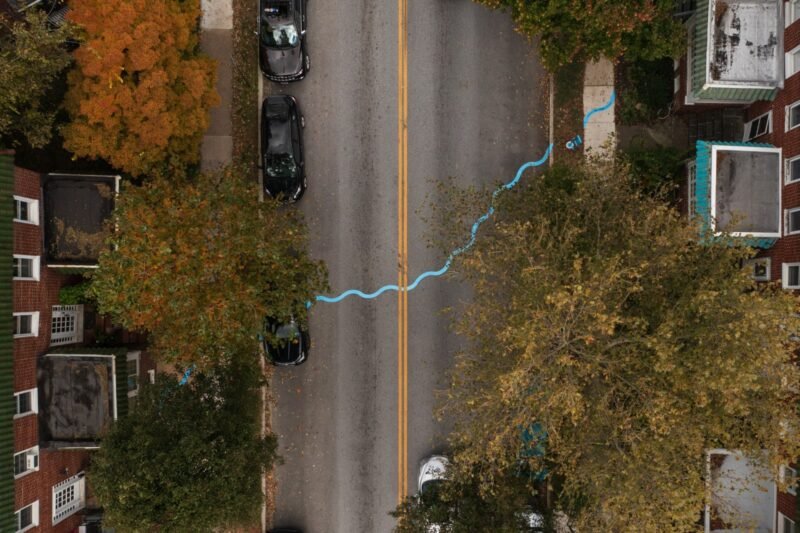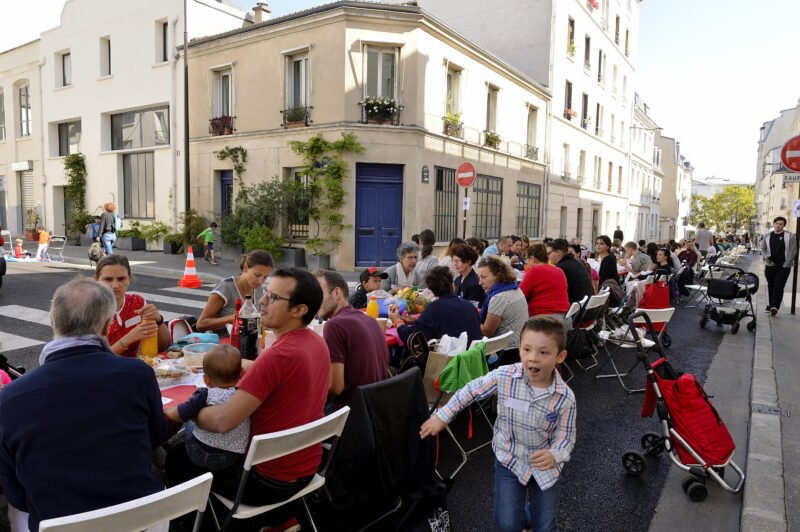#IABR — Aqueous Thinking: Art And Collectivity On The Streets Of Douala
Making cities for the future is as much about planning and policymaking as it is about designing and creating: it is a perpetual practice undertaken in boardrooms and bars, conference centres and cafés, by painters and politicians, merchants and managers. Urbane practice in urban areas, though, requires participation and reflection in order to be truly valuable, and, as we see in one Central African city, such practice can inspire collective action for the collective good.

New Walk Ways in New Bell (Photo: International Collaborative Urban Art Projects)
Featured as part of the 5th International Architecture Biennale Rotterdam is Making Douala 2007 – 2013, a travelling exhibition of doual’art’s Salon Urbain de Douala (SUD). The exhibition features a collection of public art projects realised in Cameroon’s most populous city, both from prior incarnations of the triennial SUD in 2007 and 2010, as well as a preview of next year’s edition. Making Douala highlights public artistic interventions in the city as an exercise in probing the state of the urban heart, the city’s public domain.
One such project featured in Making Douala is New Walk Ways for New Bell: Faces of Water, a public art installation organised by Kamiel Verschuren, who recently sat down for a digital chat with me regarding the project. Having worked for extended periods in the Netherlands and Japan, Verschuren sought to ply his trade in a drastically different environment. New Walk Ways is decidedly practical as far as art installations go: the project is comprised of one kilometre of wooden planks placed over top of an open sewage system in Douala’s New Bell neighbourhood, each of which contains inscribed text that refers to the qualities and the nature of water as a substance. The planks themselves have holes drilled into them to allow rainwater to enter the system while preventing garbage from falling into the stream. The holes also serve an artistic purpose: Verschuren says that “the water dripping through the holes … activates[s] the inscribed texts,” which “makes them less anonymous.” In a way, the text on the planks provokes a sense of community, both through giving certain sections of the walkways a sense of uniqueness, and also through discouraging theft because of their individuality. The holes in the planks are “an artistic coincidence in the process” to be sure, “but a good one.”

New Walk Ways in New Bell (Photo: International Collaborative Urban Art Projects)
Beyond theft prevention and water sanitation, Verschuren sees the project as playing a much more significant cultural role in inspiring a sense of collectivity. Verschuren worked with a team of locals and the chef du quartier to install the piece with great immediate effects: “not only did they make some money, they also learned technical skills, improvisation, and social logistics of organisation.” Verschuren sees this close interaction of his world, the art world, as a necessary part of art and its relation to the rest of society, as “we do not live in a time that merely requires questions to be asked.” In a way, New Walk Ways provokes individuals to take collective responsibility of clean water, the fundamental public good.
The sense of collectivity that New Walk Ways tries to inspire stretches far beyond awareness of the importance of clean drinking water. Verschuren is optimistic that the work itself provokes both policy and people, “giving them a platform to speak out and become involved” in the urban issues facing the Cameroonian city. It certainly worked: as renewal was not performed on the walkways at entrances to homes, New Bell residents started to help out with the construction of the project as a means of helping the neighbourhood’s own development. New Walk Ways avoided becoming merely “a theoretical event” in Verschuren’s words: the project became an active engagement with the community’s own public space.

Douala, Cameroon (Photo: Alvise Forcellini)
Ultimately, New Walk Ways serves as an urban strategy of intervention. Verschuren is quick to point out that “in Douala, you can do what you want, often without permission, but with a sense of responsibility”: the onus is on the community itself to maintain public space and public goods in a way that everyone living in the neighbourhood can benefit from them. Verschuren hints that Douala’s public space is one for the taking, where “space is something that is used and occupied but not something that is offered or shared.” That New Walk Ways inspires New Bell residents to take part in discussions about how the neighbourhood conducts itself is a victory in and of itself. While it certainly isn’t monumental change, that’s not the point. As Verschuren’s work in Rotterdam’s Charlois district taught him, the importance of public art is through building “a strong local network, mutual trust, and confidence” between all parties involved in maintaining the public realm.
According to Google Maps, Douala is a 6.857km drive from Rotterdam, a winding journey that meanders through seven countries, the Mediterranean, and the Sahara. Despite the distance, Verschuren sees similarities between Rotterdam and Douala. Also a port city, Douala has a similar relationship to Cameroon’s capital, Yaoundé, that Rotterdam has with Amsterdam: what is earned in Douala is spent in Yaoundé. In a sense, New Walk Ways is a project that contributes, at least in a small way, to how residents can continue making Douala, or Rotterdam, or Manila, or Edmonton: through consistent and collective engagement in protecting public space and collective resources.
Kamiel Verschuren’s work is part of Making Douala 2007 – 2013 at the International Architecture Biennale Rotterdam. Making Douala runs from 20.04.2012 to 01.06.2012 at the RiverClub Gallery in Rotterdam. Photo credits: International Collaborative Urban Art Projects and Alvise Forcellini.
 This article is part of our IABR 2012 series. As media partner of the fifth International Architecture Biennale Rotterdam, we present the highlights of 2012’s edition. Themed ‘Making City’, the IABR runs between 20 April and 12 August.
This article is part of our IABR 2012 series. As media partner of the fifth International Architecture Biennale Rotterdam, we present the highlights of 2012’s edition. Themed ‘Making City’, the IABR runs between 20 April and 12 August.



